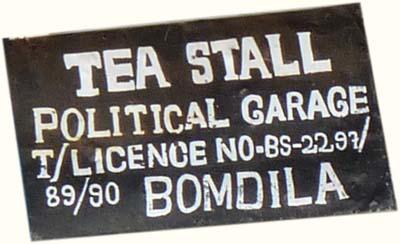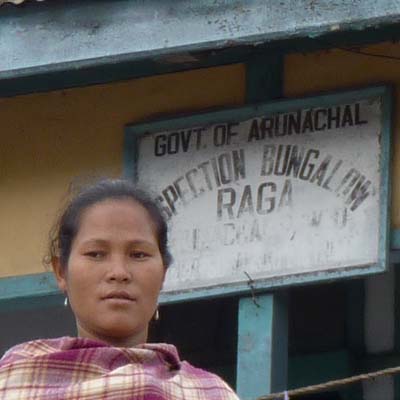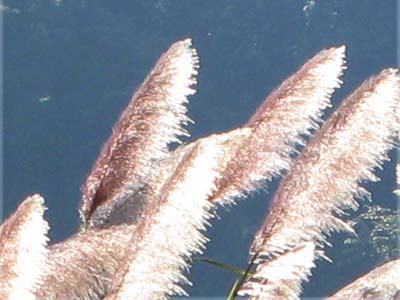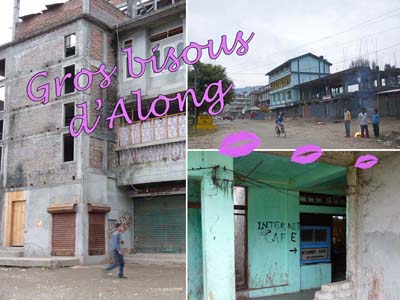| Red tape | Tour operators | Accommodation | Information & maps | |||||
| Eric & Carla | When to go | Roads | Culture | |||||
| Vegetation | Postcards | Time zone | Alternative routes |
 |
Regulations governing foreign tourists have relaxed over recent years. They are described on an Arunachal Tourism web page [dead link], which mentions that permits need to be obtained through a local tour operator and that independent travel is forbidden. There are other irritating restrictions: for instance having specified a route, you are not allowed to depart from it. It might be worthwhile including legs you have no intention of travelling for the sake of flexibility – you don’t pay more to have more circuits listed, though what would be the result I have no idea.
So far as we can tell, the requirement to travel with a local operator is widely ignored. However documents are checked along the way, so I’m surprised people get away with this. The insistence on travelling in groups of at least two (formerly four) is commonly evaded by obtaining a pass for a phantom traveller. So far as I’m aware, the authorities are happy with this.
The permit procedure takes several weeks. Allegedly some tour operators are able to obtain permits more quickly than others. You need a visa before applying for a permit; you then need to forward electronic copies of documents in order for the permit to be issued.
Tour operators
We travelled with Jungle Travels and were entirely satisfied with the service. The price was $4000 for the two of us for 24 nights, including all food and accommodation, services of a guide (Rupak) and driver (Niron), and provision of a jeep and camping equipment (which we did not use). We took our own bikes and cycling spares and also our own sleeping bags.
Rupak put a lot of effort into arranging accommodation in out-of-the-way places which would have been a struggle for us on our own. He and Niron were always on hand to offer tea and biscuits during the day, to negotiate the bureaucracy, and to support us with their sag-wagon when dusk caught us on the road. It was a pleasure to be riding light and without logistical hassle.
The main drawback of course is expense. A larger party would find it more economical, but might have less flexibility with accommodation.
Accommodation
Hotels range in quality from the very comfortable (in large centres) to the very basic (in villages). We never stayed in any of the places serving local peasants; evidently Rupak didn’t think much of them.
It isn’t always easy to recognise hotels, since in this part of India the word ‘hotel’ is often applied to tea-houses (the Punjabi term ‘dhaba’ not being used here). Some places calling themselves hotels amplify the description by saying ‘fooding and lodging’ or ‘fooding only’.
 |
Usually the resthouse is a bungalow with four largish but spartan bedrooms, each having a basic but functional bathroom, and with a shared sitting room.
Camping: we doubted the campability of the terrain in advance, and saw few good camping spots as we travelled through. The military don’t like people to camp within view of their establishments.
There is easy camping on the northern slopes of the Se La above Jang. We thought there was a good spot on the south side at N27°25·789' E92°07·422' and a good riverside spot between Along and Pasighat near N28°07·976' E96°06·814'; otherwise you’re left to your ingenuity. Evidently Eric and Carla managed (see below).
Information and maps
There is very little information available and the maps (with the exception of those on this site) are antiquated or unreliable.
Arunachal Tourism have a website providing a little information. We got no reply from the email contact addresses given there, eventually resorting to telephone. Jungle Travels were helpful, but one would rather start one’s planning with unfiltered information.
During an earlier visit to India we’d bought Outlook Traveller’s 75 Holidays in the Hills which has brief sections on Tawang and Ziro.
The satellite images on Google Earth show some of the roads in the Tawang district, but the user-added material is unreliable and often dishonest, having been put there for Chinese propaganda purposes.
We met another couple of cycle tourists on the road, Eric and Carla from the Netherlands. They’d obtained a permit from a tour operator who hadn’t insisted on accompanying them and were travelling independently. They had full camping gear so we quickly overtook them. They camped at –10° on the Se La: rather them than us.
Unfortunately they both went down with upset stomachs at Bomdila and lost a couple of days there. However they made it to Tawang, from where, rather than retrace their steps, they travelled by helicopter to Itanagar, riding onwards to Ziro and ultimately Pasighat.
They mention having heard of a Bhutanese cyclist who’d ridden in the region, depriving us of any claim to be the first.
Their web site (in Dutch) is http://www.carlaeneric.nl/. Unfortunately Google makes a hash of translating it.
When to go
The monsoon starts earlier, ends later, and falls heavier in the eastern than the western Himalaya; and (owing to the influence of the Bay of Bengal) the dry season is not as dry. Indian sources often recommend visiting Arunachal during the monsoon, which must be the worst possible time (Outlook Traveller says April–November for Ziro); however the Indians have a highly developed appreciation of rain and may be glad to escape the lowlands at this time. November/December, when we went ourselves, is probably best.
Roads
The roads are tarmac all the way except for a few stretches about 10km long where the surface has disappeared. The tarmac isn’t bad. There’s a fair amount of military traffic – much of it in convoy – along the route Bhalukpong–Bomdila–Tawang but the other roads almost traffic-free.
We measured gradients of 20% over three short stretches.
Smashing whisky bottles on the roads seems to be the traditional Arunachali way of expressing enjoyment. We had no punctures, but carried our bikes over the worst stretches and stopped to examine our tyres whenever we inadvertently rode through glass.
Our route didn’t give us much acclimatisation before the Se La, and the geography doesn’t help. An approach via the Manda La would certainly be better if you could get away with it.
Culture
The Tawang district is Tibetan Buddhist. It was ceded by Tibet to the British Empire by the Simla Accord of 1914 (which the Chinese government repudiates) but continued to be administered by Tibet until at least 1939.
Tawang gompa is said to be the second largest in the world, but the Buddhist sites in Arunachal seem to me less interesting than those in other places, notably Ladakh. The Tawang gompa is striking chiefly from its situation, but much of it is new. Several of the smaller gompas in the neighbourhood have undergone unsympathetic restoration, some if it in preparation for the Dalai Lama’s 2010 visit. In one case the interior has been refurbished with wood-effect plastic-coated plywood.
In retrospect Dirang Dzong was the most evocative of the Tibetan places we visited.
 |
The most important ritual for Donyi Polo followers is the slaughter of mithun, a semi-wild floppy-eared cow/buffalo hybrid. Although the mithun are supposed to be hunted they cannot constitute very challenging game since they like sleeping on the nice warm roads.
Evangelical Christianity is making inroads into Arunachal, and one of the conditions of an entry permit is that the holder will not ‘indulge in missionary activities’. We were told that the main appeal of Christianity was financial, since adherents are saved the expense of slaughtering mithun.
The hilltribes do not share the food taboos of the rest of India, being willing eaters of beef, pork and grubs. However the food served to tourists is standard fare.
H.W. Tilman travelled in the Tawang district in 1939 and was told that the hilltribes further east ‘had not yet entirely given up raiding the plains for slaves’. Tibetan rule was probably rather nominal.
 |
At low altitudes the vegation is jungle: banana palms, fan palms, bamboo. Creepers colonise dead stumps and telegraph poles. Poinsettia is commonly used for hedging, and on the Ziro circuit a sort of pink-flowered pampas grass is commonly seen, fading as the season progresses.
Higher up there are deciduous and coniferous forest and various forms of shrub and meadow, with occasional autumn-flowering Himalayan cherries among them.
 |
Owing to the small number of foreign tourists postcards are unobtainable, but fortunately we are able to remedy this for future visitors. Simply click on the thumbnail and print as many copies as you need.
Time zone
The whole of India shares a common time zone with the effect that the sun rises early by clock time in the east and late in the west. During our visit sunrise was at 5:30 and sunset at 5:00. This wouldn’t matter if people adjusted the hours they kept accordingly, as peasants no doubt do; but institutions aren’t so flexible, and school hours, for instance, start at 9:00 everywhere. Daylight is lost as a result.
You might expect the notoriously restive Calcuttans to protest about having their daylight stolen by central government, but this would require them to get out of bed in good time, which is not in their nature: nothing opens in Calcutta before 10 in the morning, by which time the sun is not far from its zenith.
Alternative routes
The Tawang and Ziro routes have been open to foreign visitors (subject to fluctuating restrictions) for many years. In 2008 a number of additional circuits were opened, listed on the Arunachal Tourism web site. (The place names it mentions are hard to find on maps.) We decided against taking advantage of the new circuits on the grounds that they were there-and-back routes, that they appeared to slink along river valleys, and (in blissful ignorance of the level of development elsewhere) that they would lack tourist infrastructure.
A road is being built linking Tawang to Tashigang in Bhutan. In fact the Tawang Chu stream flows directly into Bhutan at a height of less than 1500m whereas all connections elsewhere cross high passes. Yet there do not seem to be any communications along the valley, and we understand that the road will largely follow the ridge system starting at the Se La. If it is open to tourists it will offer an attractive circular route.